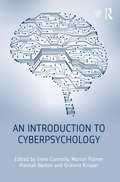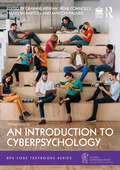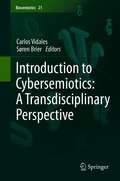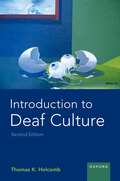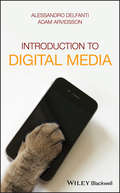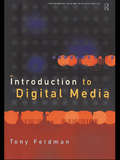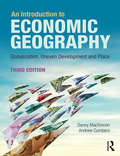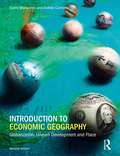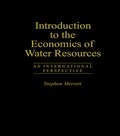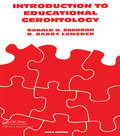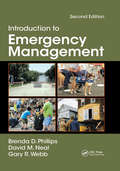- Table View
- List View
An Introduction to Cyberpsychology (BPS Core Textbooks Series)
by Irene Connolly, Palmer Marion, Barton Hannah and Kirwan GráinneAn Introduction to Cyberpsychology is the first book to provide a student-oriented introduction to this rapidly growing and increasingly studied topic. It is designed to encourage students to critically evaluate the psychology of online interactions, and to develop appropriate research methodologies to complete their own work in this field. The book is comprised of four main sections: An overview of cyberpsychology and online research methodologies Social psychology in an online context The practical applications of cyberpsychology The psychological aspects of other technologies. Each chapter includes: Explanations of key terms and a glossary to facilitate understanding Content summaries to aid student learning Activity boxes, discussion questions and recommended reading to guide further study. Further resources for students and instructors are available on the book’s companion website, including audio and video links, essay questions, a multiple-choice test bank, and PowerPoint lecture slides. Uniquely combining a survey of the field with a focus on the applied areas of psychology, the book is designed to be a core text for undergraduate modules in cyberpsychology and the psychology of the internet, and a primer for students of postgraduate programs in cyberpsychology.
An Introduction to Cyberpsychology (BPS Core Textbooks Series)
by Gráinne Kirwan Irene Connolly Hannah Barton Marion PalmerAn Introduction to Cyberpsychology is the first book to provide a student-oriented introduction to this rapidly growing and increasingly studied topic. It is designed to encourage students to critically evaluate the psychology of online interactions, and to develop appropriate research methodologies to complete their own work in this field. The book is comprised of four main sections: An overview of cyberpsychology and online research methodologies Social psychology in an online context The practical applications of cyberpsychology The psychological aspects of other technologies. Each chapter includes: Explanations of key terms and a glossary to facilitate understanding Content summaries to aid student learning Activity boxes, discussion questions and recommended reading to guide further study. Further resources for students and instructors are available on the book’s companion website, including audio and video links, essay questions, a multiple-choice test bank, and PowerPoint lecture slides. Uniquely combining a survey of the field with a focus on the applied areas of psychology, the book is designed to be a core text for undergraduate modules in cyberpsychology and the psychology of the internet, and a primer for students of postgraduate programs in cyberpsychology.
An Introduction to Cyberpsychology (BPS Core Textbooks Series)
An Introduction to Cyberpsychology provides a comprehensive introduction to this rapidly growing discipline. Fully updated in its second edition, the book encourages students to critically evaluate the psychology of online interactions and to develop appropriate research methodologies to complete their own work in this field.The book examines cyberpsychology and online research methodologies, social psychology in an online context, practical applications of cyberpsychology, and the psychological aspects of other technologies. This new edition has been carefully updated to include additional coverage of: Expanded content relating to major developments in the field and new content on gaming and screentime A new chapter examining the relationship between older adults and technology Cyberpsychology in focus feature boxes in each chapter that examine topics in depth Interviews with professionals working in fields relating to cyberpsychology Each chapter includes key terms and a glossary, content summaries, discussion questions, and recommended reading to guide further study.Supported by extensive online resources for students and instructors, this authoritative book is an essential core text for undergraduate modules in cyberpsychology, and an ideal primer for students of postgraduate programs in cyberpsychology.To view the additional student and instructor resources for this book, please visit bpscoretextbooks.routledge.com
Introduction to Cybersemiotics: A Transdisciplinary Perspective (Biosemiotics #21)
by Carlos Vidales Søren BrierThis book traces the origins and evolution of cybersemiotics, beginning with the integration of semiotics into the theoretical framework of cybernetics and information theory. The book opens with chapters that situate the roots of cybersemiotics in Peircean semiotics, describe the advent of the Information Age and cybernetics, and lay out the proposition that notions of system, communication, self-reference, information, meaning, form, autopoiesis, and self-control are of equal topical interest to semiotics and systems theory. Subsequent chapters introduce a cybersemiotic viewpoint on the capacity of arts and other practices for knowing. This suggests pathways for developing Practice as Research and practice-led research, and prompts the reader to view this new configuration in cybersemiotic terms. Other contributors discuss cultural and perceptual shifts that lead to interaction with hybrid environments such as Alexa. The relationship of storytelling and cybersemiotics is covered at chapter length, and another chapter describes an individual-collectivity dialectics, in which the latter (Commind) constrains the former (interactants), but the former fuels the latter. The concluding chapter begins with the observation that digital technologies have infiltrated every corner of the metropolis - homes, workplaces, and places of leisure - to the extent that cities and bodies have transformed into interconnected interfaces. The book challenges the reader to participate in a broader discussion of the potential, limitations, alternatives, and criticisms of cybersemiotics.
An Introduction to Data Analysis: Quantitative, Qualitative and Mixed Methods
by Tiffany BerginCovering the general process of data analysis to finding, collecting, organizing, and presenting data, this book offers a complete introduction to the fundamentals of data analysis. Using real-world case studies as illustrations, it helps readers understand theories behind and develop techniques for conducting quantitative, qualitative, and mixed methods data analysis. With an easy-to-follow organization and clear, jargon-free language, it helps readers not only become proficient data analysts, but also develop the critical thinking skills necessary to assess analyses presented by others in both academic research and the popular media. It includes advice on: - Data analysis frameworks - Validity and credibility of data - Sampling techniques - Data management - The big data phenomenon - Data visualisation - Effective data communication Whether you are new to data analysis or looking for a quick-reference guide to key principles of the process, this book will help you uncover nuances, complexities, patterns, and relationships among all types of data.
An Introduction to Data Analysis: Quantitative, Qualitative and Mixed Methods
by Tiffany BerginCovering the general process of data analysis to finding, collecting, organizing, and presenting data, this book offers a complete introduction to the fundamentals of data analysis. Using real-world case studies as illustrations, it helps readers understand theories behind and develop techniques for conducting quantitative, qualitative, and mixed methods data analysis. With an easy-to-follow organization and clear, jargon-free language, it helps readers not only become proficient data analysts, but also develop the critical thinking skills necessary to assess analyses presented by others in both academic research and the popular media. It includes advice on: - Data analysis frameworks - Validity and credibility of data - Sampling techniques - Data management - The big data phenomenon - Data visualisation - Effective data communication Whether you are new to data analysis or looking for a quick-reference guide to key principles of the process, this book will help you uncover nuances, complexities, patterns, and relationships among all types of data.
Introduction to Deaf Culture (PROF PERSPECTIVES ON DEAFNESS SERIES)
by Thomas K. HolcombThomas K Holcomb's highly successful textbook on Deaf culture has been fully revised and updated in this second edition. The changes reflect those in the field and include three new chapters focusing on the impact of technology on the Deaf experience, the roles of allies in supporting the Deaf community, and the diversity that exists in the Deaf community. Also new to this edition is an ASL summary of each chapter, making the book accessible in two languages that are important in the Deaf community, ASL and English. The book provides a broad yet in-depth exploration of how Deaf people are best understood from a cultural perspective. It explores the tension between the Deaf and disabled communities, the cultural norms of the Deaf community, Deaf art and literature, the solutions being offered by the medical and Deaf communities for effective living as Deaf individuals, and an analysis of the universality of the Deaf experience. As a member of a multigenerational Deaf family with a lifetime of experience living bi-culturally among Deaf and hearing people, author Thomas K. Holcomb enhances the academic discussions with engaging stories and the poetry and art of Deaf individuals. In addition to being used in college-level courses, this book can also help parents and educators of Deaf children understand the world of Deaf culture. It offers a beautiful introduction to the ways Deaf people effectively manage their lives in a world full of people who hear.
Introduction to Deaf Culture (PROF PERSPECTIVES ON DEAFNESS SERIES)
by Thomas K. HolcombThomas K Holcomb's highly successful textbook on Deaf culture has been fully revised and updated in this second edition. The changes reflect those in the field and include three new chapters focusing on the impact of technology on the Deaf experience, the roles of allies in supporting the Deaf community, and the diversity that exists in the Deaf community. Also new to this edition is an ASL summary of each chapter, making the book accessible in two languages that are important in the Deaf community, ASL and English. The book provides a broad yet in-depth exploration of how Deaf people are best understood from a cultural perspective. It explores the tension between the Deaf and disabled communities, the cultural norms of the Deaf community, Deaf art and literature, the solutions being offered by the medical and Deaf communities for effective living as Deaf individuals, and an analysis of the universality of the Deaf experience. As a member of a multigenerational Deaf family with a lifetime of experience living bi-culturally among Deaf and hearing people, author Thomas K. Holcomb enhances the academic discussions with engaging stories and the poetry and art of Deaf individuals. In addition to being used in college-level courses, this book can also help parents and educators of Deaf children understand the world of Deaf culture. It offers a beautiful introduction to the ways Deaf people effectively manage their lives in a world full of people who hear.
An Introduction to Design and Culture: 1900 to the Present
by Penny SparkeThis third edition of An Introduction to Design and Culture has been revised and updated throughout to include issues of globalization, sustainability and digital/interactive design. New for this edition is a chapter which covers key changes in design culture. Design culture has changed dramatically in the 21st century, the designer-hero is now much less in evidence and design has become much more interdisciplinary. Drawing on a wealth of mass-produced artefacts, images and environments including sewing machines, cars, televisions, clothes, electronic and branded goods and exhibitions, author Penny Sparke shows how design has helped to shape and reflect our social and cultural development. This introduction to the development of modern (and postmodern) design is ideal for undergraduate students.
An Introduction to Design and Culture: 1900 to the Present
by Penny SparkeThis third edition of An Introduction to Design and Culture has been revised and updated throughout to include issues of globalization, sustainability and digital/interactive design. New for this edition is a chapter which covers key changes in design culture. Design culture has changed dramatically in the 21st century, the designer-hero is now much less in evidence and design has become much more interdisciplinary. Drawing on a wealth of mass-produced artefacts, images and environments including sewing machines, cars, televisions, clothes, electronic and branded goods and exhibitions, author Penny Sparke shows how design has helped to shape and reflect our social and cultural development. This introduction to the development of modern (and postmodern) design is ideal for undergraduate students.
An Introduction to Design and Culture: 1900 to the Present
by Penny SparkeAn Introduction to Design and Culture provides a comprehensive guide to the changing relationships between design and culture from 1900 to the present day with an emphasis on five main themes: Design and consumption Design and technology The design profession Design theory Design and identities This fourth edition extends the traditional definition of design as covering product design, furniture design, interior design, fashion design and graphic design to embrace its more recent manifestations, which include service design, user-interface design, co-design, and sustainable design, among others. It also discusses the relationship between design and the new media and the effect of globalisation on design. Taking a broadly chronological approach, Professor Sparke employs historical methods to show how these themes developed through the twentieth century and into the twenty-first century and played a role within modernism, postmodernism and beyond. Over a hundred illustrations are used throughout to demonstrate the breadth of design and examples – among them design in Modern China, the work of Apple Computers Ltd., and design thinking – are used to elaborate key ideas. The new edition remains essential reading for undergraduate and postgraduate students of design studies, cultural studies and visual arts.
An Introduction to Design and Culture: 1900 to the Present
by Penny SparkeAn Introduction to Design and Culture provides a comprehensive guide to the changing relationships between design and culture from 1900 to the present day with an emphasis on five main themes: Design and consumption Design and technology The design profession Design theory Design and identities This fourth edition extends the traditional definition of design as covering product design, furniture design, interior design, fashion design and graphic design to embrace its more recent manifestations, which include service design, user-interface design, co-design, and sustainable design, among others. It also discusses the relationship between design and the new media and the effect of globalisation on design. Taking a broadly chronological approach, Professor Sparke employs historical methods to show how these themes developed through the twentieth century and into the twenty-first century and played a role within modernism, postmodernism and beyond. Over a hundred illustrations are used throughout to demonstrate the breadth of design and examples – among them design in Modern China, the work of Apple Computers Ltd., and design thinking – are used to elaborate key ideas. The new edition remains essential reading for undergraduate and postgraduate students of design studies, cultural studies and visual arts.
Introduction to Digital Media
by Alessandro Delfanti Adam ArvidssonNew and updated English translation of the highly successful book on digital media This book introduces readers to the vast and rich world of digital media. It provides a strong starting point for understanding digital media’s social and political significance to our culture and the culture of others—drawing on an emergent and increasingly rich set of empirical and theoretical studies on the role and development of digital media in contemporary societies. Touching on the core points behind the discipline, the book addresses a wide range of topics, including media economics, online cooperation, open source, social media, software production, globalization, brands, marketing, the cultural industry, labor, and consumption. Presented in six sections—Media and Digital Technologies; The Information Society; Cultures and Identities; Digital Collaboration; Public Sphere and Power; Digital Economies—the book offers in-depth chapter coverage of new and old media; network infrastructure; networked economy and globalization; the history of information technologies; the evolution of networks; sociality and digital media; media and identity; collaborative media; open source and innovation; politics and democracy; social movements; surveillance and control; digital capitalism; global inequalities and development; and more. Delivers a reliable, compact and quick introduction to the core issues analyzed by digital culture studies and sociology of information societies Interweaves main topics and theories with several examples and up-to-date case studies, often linked to our everyday lives on the internet, as well as suggestions for further readings Anchors examples to discussions of the main sociological, political, and anthropological theoretical approaches at stake to help students make sense of the changes brought about by digital media Uses critical sociological and political theory alongside every day examples to discuss concepts such as online sociality, digital labor, digital value creation, and the reputation economy Clear and concise throughout, Introduction to Digital Media is an excellent primer for those teaching and studying digital culture and media.
Introduction to Digital Media
by Alessandro Delfanti Adam ArvidssonNew and updated English translation of the highly successful book on digital media This book introduces readers to the vast and rich world of digital media. It provides a strong starting point for understanding digital media’s social and political significance to our culture and the culture of others—drawing on an emergent and increasingly rich set of empirical and theoretical studies on the role and development of digital media in contemporary societies. Touching on the core points behind the discipline, the book addresses a wide range of topics, including media economics, online cooperation, open source, social media, software production, globalization, brands, marketing, the cultural industry, labor, and consumption. Presented in six sections—Media and Digital Technologies; The Information Society; Cultures and Identities; Digital Collaboration; Public Sphere and Power; Digital Economies—the book offers in-depth chapter coverage of new and old media; network infrastructure; networked economy and globalization; the history of information technologies; the evolution of networks; sociality and digital media; media and identity; collaborative media; open source and innovation; politics and democracy; social movements; surveillance and control; digital capitalism; global inequalities and development; and more. Delivers a reliable, compact and quick introduction to the core issues analyzed by digital culture studies and sociology of information societies Interweaves main topics and theories with several examples and up-to-date case studies, often linked to our everyday lives on the internet, as well as suggestions for further readings Anchors examples to discussions of the main sociological, political, and anthropological theoretical approaches at stake to help students make sense of the changes brought about by digital media Uses critical sociological and political theory alongside every day examples to discuss concepts such as online sociality, digital labor, digital value creation, and the reputation economy Clear and concise throughout, Introduction to Digital Media is an excellent primer for those teaching and studying digital culture and media.
An Introduction to Digital Media
by Tony FeldmanIn this clear and highly accessible book, Tony Feldman provides an account of the evolution and application of digital media. Clarifying its underlying technologies, he identifies its immense commercial and human potential. Using as a starting point a simplification which considers new media in two distinct sectors; packaged 'off-line' media such as CD-ROMs; and the world of transmitted media which includes digital broadcasting and interactive online services, Feldman provides a comprehensive overview of the digital media landscape. Focusing on multimedia and the entertainment media he describes and analyses the spectacular rise of CD-based information and the equally revolutionary development of the Internet and online services. Set within a commercial context, readers can identify the potential to generate revenue and profit from the new media. An Introduction to Digital Media concludes with a strategic assessment of the implications of going digital for individuals, companies and corporations.
An Introduction to Digital Media
by Tony FeldmanIn this clear and highly accessible book, Tony Feldman provides an account of the evolution and application of digital media. Clarifying its underlying technologies, he identifies its immense commercial and human potential. Using as a starting point a simplification which considers new media in two distinct sectors; packaged 'off-line' media such as CD-ROMs; and the world of transmitted media which includes digital broadcasting and interactive online services, Feldman provides a comprehensive overview of the digital media landscape. Focusing on multimedia and the entertainment media he describes and analyses the spectacular rise of CD-based information and the equally revolutionary development of the Internet and online services. Set within a commercial context, readers can identify the potential to generate revenue and profit from the new media. An Introduction to Digital Media concludes with a strategic assessment of the implications of going digital for individuals, companies and corporations.
An Introduction to Economic Geography: Globalisation, Uneven Development and Place
by Andrew Cumbers Danny MacKinnonIn the context of great economic turmoil and uncertainty, the emergent conflict between continued globalisation and growing economic nationalism means that a geographical economic perspective has never been so important. An Introduction to Economic Geography guides students through the key debates of this vibrant area, exploring the range of ideas and approaches that invigorate the wider discipline. This third edition includes new chapters on finance, cities and the digital economy, consumption and the environment. Underpinned by the themes of globalisation, uneven development and place, the text conveys the diversity of contemporary economic geography and explores the social and spatial effects of global economic restructuring. It combines a critical geographical perspective on the changing economic landscape with an appreciation of contemporary themes such as neoliberalism, financialisation, innovation and the growth of new technologies. An Introduction to Economic Geography is an essential textbook for undergraduate students taking courses in Economic Geography, Globalisation Studies and more broadly in Human Geography. It will also be of much interest to those in Planning, Business and Management Studies and Economics.
Introduction to Economic Geography: Globalization, Uneven Development and Place
by Danny MacKinnon Andrew CumbersToday's rapidly flowing global economy, hit by recession following the financial crisis of 2008/9, means the geographical economic perspective has never been more important. An Introduction to Economic Geography comprehensively guides you through the core issues and debates of this vibrant and exciting area, whilst also exploring the range of approaches and paradigms currently invigorating the wider discipline. Rigorous and accessible, the authors demystify and enliven a crucial subject for geographical study. Underpinned by the themes of globalisation, uneven development and place, the text explores the diversity and vitality of contemporary economic geography. It balances coverage of 'traditional' areas such as regional development and labour markets with insight into new and evolving topics like neoliberalism, consumption, creativity and alternative economic practices. An Introduction to Economic Geography is an essential textbook for undergraduate students taking courses in Economic Geography, Globalisation Studies and more broadly in Human Geography. It will also be of key interest to anyone in Planning, Business and Management Studies and Economics.
Introduction to Economic Geography: Globalization, Uneven Development and Place
by Danny MacKinnon Andrew CumbersToday's rapidly flowing global economy, hit by recession following the financial crisis of 2008/9, means the geographical economic perspective has never been more important. An Introduction to Economic Geography comprehensively guides you through the core issues and debates of this vibrant and exciting area, whilst also exploring the range of approaches and paradigms currently invigorating the wider discipline. Rigorous and accessible, the authors demystify and enliven a crucial subject for geographical study. Underpinned by the themes of globalisation, uneven development and place, the text explores the diversity and vitality of contemporary economic geography. It balances coverage of 'traditional' areas such as regional development and labour markets with insight into new and evolving topics like neoliberalism, consumption, creativity and alternative economic practices. An Introduction to Economic Geography is an essential textbook for undergraduate students taking courses in Economic Geography, Globalisation Studies and more broadly in Human Geography. It will also be of key interest to anyone in Planning, Business and Management Studies and Economics.
Introduction To The Economics Of Water Resources: An International Perspective
by Stephen MerrettFirst published in 1997. Routledge is an imprint of Taylor & Francis, an informa company.
Introduction To The Economics Of Water Resources: An International Perspective
by Stephen MerrettFirst published in 1997. Routledge is an imprint of Taylor & Francis, an informa company.
Introduction to Educational Gerontology (Series in Death, Dying, and Bereavement)
by Ronald H. Sherron D. Barry LumsdenEducational gerontology is the study of the changes in the learning process caused by old age. This new edition provides an update of developments in this field of research. The volume probes topics such as implications for education for the aging, reminiscence, methods of teaching, social exchange and equal opportunity.
Introduction to Educational Gerontology (Series in Death, Dying, and Bereavement)
by Ronald H. Sherron D. Barry LumsdenEducational gerontology is the study of the changes in the learning process caused by old age. This new edition provides an update of developments in this field of research. The volume probes topics such as implications for education for the aging, reminiscence, methods of teaching, social exchange and equal opportunity.
Introduction to Emergency Management
by Damon P. Coppola Jane A. Bullock George D. HaddowIntroduction to Emergency Management, Seventh Edition, sets the standard for excellence in the field and has educated a generation of emergency managers. This long-trusted resource provides a broad overview of the key aspects of the emergency management profession. Readers will gain an understanding of why the emergency management profession exists, what actions its professionals and practitioners are tasked with performing, and what achievements are sought through the conduct of these various efforts. Students and new professionals alike will further gain an enhanced understanding of key terminology and concepts that enable them to work with emergency management specialists.Emphasizes climate change as a key hazard faced by disaster managersIncludes coverage of social media as a critical tool in emergency managementContains updated ancillaries, new examples, and case studies throughout
Introduction to Emergency Management
by Brenda Phillips David M. Neal Gary WebbEmergency management university programs have experienced dramatic and exponential growth over the last twelve years. This new, fully updated edition introduces majors and minors to the field and provides content accessible to those students taking introductory emergency management courses. The book’s student-centered focus looks at the regional, state, and local level response, as well as some of the often misunderstood or overlooked social aspects of disasters. Real-world cases are described throughout including considerations of international emergency management and disasters alongside features from former students now working as professionals in the field of emergency management.
